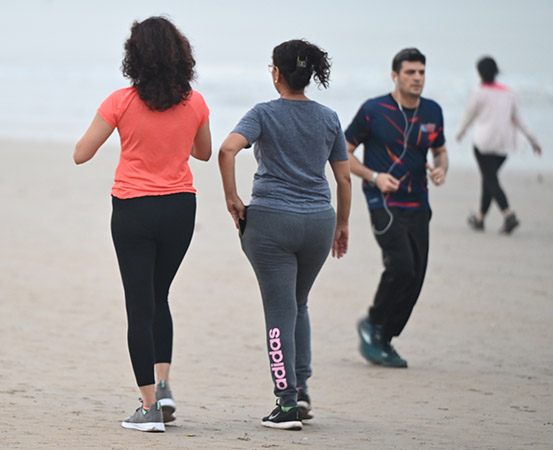
Gone are the days when choosing active wear was as simple as putting on a T-shirt and shorts. The kind of clothes you wear has a huge bearing on your performance while playing sport or doing any form of physical activity or exercise, say experts. Exercise wear, workout outfit or sportswear come highly customised these days — designed for specific sports, the weather and even the intensity of the activity, among many things.
The most basic choice, which almost everyone makes, revolves around how heavy the material is. It is advisable to not wear clothes that are too heavy or cling to the body after absorbing moisture or sweat. Fabrics that are light and can remove moisture from the body are ideal.
Which active wear fabric suits best?
While personal preference or taste does have a say in the kind of active wear fabric people choose, it is also important to keep the weather in mind. Thermoregulation of the body is important. The body temperature rises during any form of physical exertion, triggering sweating (the body’s thermoregulation mechanism). The moisture has to evaporate from the skin surface for the body to cool down. The clothes you wear have a bearing on the rate of evaporation of moisture from the skin — and thereby the rate of cooling.
“The fabric shouldn’t restrict your movement,” says Sunil Kumar, a Bengaluru-based fitness trainer. “It shouldn’t cause your body to heat up unnaturally or cool down unnaturally, that is, it should help you maintain a particular body temperature.”
Factors to consider while deciding active wear
Apart from weather conditions, some other factors should also be considered while choosing active wear:
- The type of activity: “When you are playing football, you cannot wear something too tight, because [what you wear] needs to help you move better,” says Kumar. “In swimming, the fabric is completely different — it needs to be water-resistant [and], at the same time, it needs to keep you tight, because the smaller you are, the faster you go in water [since] the resistance is minimal. So, your clothing needs to change according to the sport, according to the activity.”
- Weight of the fabric: While heavier clothes are generally not preferred, they are required for certain activities, especially those at high altitude. “If it doesn’t involve any temperature-related or altitude-related activity, then the fabric can preferably be light,” says Kumar.
- Colour of the outfit: Different colours absorb and trap heat differently. “Darker colours absorb more light and so retain the heat inside,” says Kumar. “Lighter ones repel light, so doesn’t retain the heat. So, there is an added advantage of thermal regulation if you’re wearing lighter colours in summer and darker colours during winter.” Gautam Sangappa, a fitness consultant and founder of Proton Fitness Academy, Bengaluru, says a light shade like white or fluorescent colours are far better when you are working out in the sun.
- Moisture- or sweat-wicking capacity: Moisture-wicking capacity of the fabric is its ability to quickly pull the moisture or sweat from the skin’s surface and allow it to evaporate. “Sweat can hinder performance, so sweat-wicking material would be better for active wear,” says Kumar.
- Comfort level: The type of fabric, the size and the fit of the clothes determine the comfort level. “You will also have to see what’s the right fit for you,” says Sangappa. “Many people just go for very tight or very loose clothing that is tight at certain corners. So, one must see their comfort and that the clothing does not cause chafing. It should allow them to comfortably do all the movements that they want to do.”
Cotton vs Dri-FIT
While cotton remains most people’s choice of fabric for exercise wear due to the comfort it provides, Dri-FIT, made of polyester or a bend of polyester and cotton, is also used because it has good breathability, doesn’t retain moisture and enhances movement.
“Cotton or a mix of cotton helps absorb all the sweat, which is most important because if the sweat is not getting absorbed by the cloth that you’re wearing, it will lead to a lower performance when it comes to your workout,” adds Sangappa. “You tend to feel a little more irritable, and you don’t give your 100%. Cotton is comfortable, the cloth helps you breathe, especially for a normal person who’s just working to keep himself fit. During cold weather, if you wear cotton and exercise, your body tends to cool down fast, so you need more complex warm-up routines.”
In winter, woollen clothes can also be used as exercise wear.
“If you’re exercising in cold [weather], wool is by far the best because even if you sweat, it will not let you cool down and helps maintain the heat,” says Sangappa. “Nowadays there are other polyester materials in which there are many layers but the innermost layer is similar to wool.”
Takeaways
- While choosing active wear, it is important to consider the weather conditions, fabric material, colour, weight, moisture-wicking capacity, comfort level and type of activity.
- While cotton provides comfort and good breathability, Dri-FIT is an option too in summer as it doesn’t retain moisture and enhances movement.
- If you’re working out in the cold, wool is by far the best — even if you sweat, it will not let you cool down and helps maintain the heat. Plus, there are other polyester materials in which there are many layers.

















